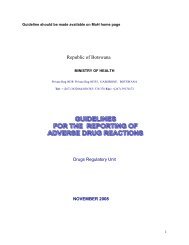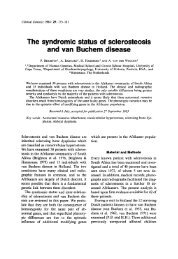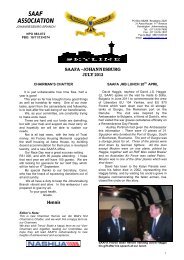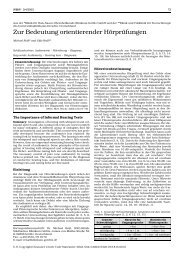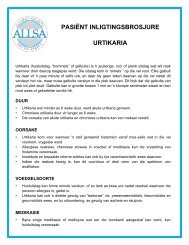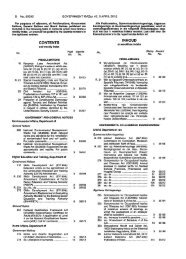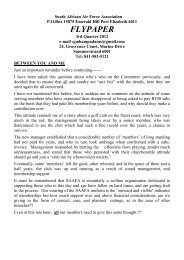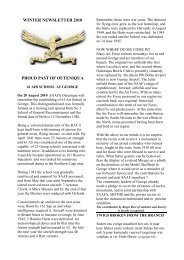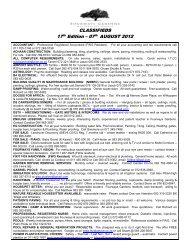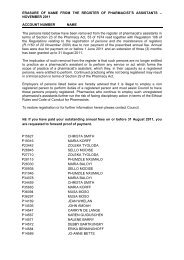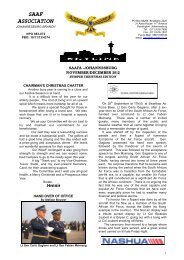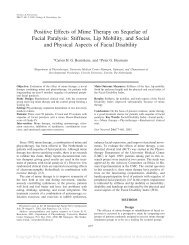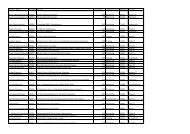Bell's Palsy: The Spontaneous Course of 2,500 Peripheral ... - Admin
Bell's Palsy: The Spontaneous Course of 2,500 Peripheral ... - Admin
Bell's Palsy: The Spontaneous Course of 2,500 Peripheral ... - Admin
You also want an ePaper? Increase the reach of your titles
YUMPU automatically turns print PDFs into web optimized ePapers that Google loves.
Bell’s palsy 13<br />
Table IX. Grades <strong>of</strong> palsy in the Peitersen grading<br />
system<br />
Grade<br />
Degree <strong>of</strong><br />
palsy<br />
Description <strong>of</strong> palsy<br />
0 None<br />
I Slight<br />
II Moderate<br />
III Severe<br />
IV Complete<br />
Normal function<br />
Only visible when patient grimaces<br />
Visible with small facial movements<br />
Function just visible<br />
No function<br />
Table X. Description <strong>of</strong> sequelae associated with<br />
grades 0–IV <strong>of</strong> palsy in the Peitersen grading system<br />
Fig. 10. Distribution <strong>of</strong> degree <strong>of</strong> recovery for the patients<br />
with Bell’s palsy.<br />
Figure 11 shows the types <strong>of</strong> initial damage <strong>of</strong> the<br />
facial nerve. A total <strong>of</strong> 85% <strong>of</strong> patients experienced<br />
different types <strong>of</strong> damage, such as neuropraxia, axonotmesis,<br />
neurotmesis and partial degeneration. For<br />
all these patients recovery began within 3 weeks after<br />
the onset <strong>of</strong> palsy. Only 15% <strong>of</strong> patients suffered total<br />
degeneration <strong>of</strong> the nerve, with recovery beginning<br />
]3 months after the onset <strong>of</strong> palsy.<br />
Figure 12 demonstrates the nal outcomes after<br />
recovery. As mentioned above, 83% <strong>of</strong> patients had a<br />
good outcome and 17% a bad outcome.<br />
Comparison <strong>of</strong> the results shown in Figs 11 and 12<br />
shows that there is a very clear connection between<br />
early pathology in the facial nerve and the nal<br />
outcome. A total <strong>of</strong> 85% <strong>of</strong> patients had a ‘‘mild<br />
pathology’’ and 83% achieved a fair nal result. A<br />
total <strong>of</strong> 15% <strong>of</strong> patients had a ‘‘severe pathology’’,<br />
namely total degeneration <strong>of</strong> the nerve. All <strong>of</strong> these<br />
patients (and 17% in total) were in the group with<br />
severe sequelae.<br />
A comparison <strong>of</strong> my scale <strong>of</strong> sequelae and that<br />
designed by House and Brackmann (40) is possible to<br />
some extent. If their grades IV and V are combined<br />
then the new group is almost identical to my grade<br />
III (Table XI). <strong>The</strong> number <strong>of</strong> Bell’s palsy patients in<br />
this group is very small and to the best <strong>of</strong> my<br />
knowledge it is very dif cult to distinguish between<br />
House and Brackmann’s grades IV and V.<br />
<strong>The</strong> distribution <strong>of</strong> sequelae is listed in Table XII.<br />
Paresis is the commonest sequela but not the most<br />
uncomfortable for the patients. Associated movements<br />
and contracture were found in 16% and 17% <strong>of</strong><br />
the sample, respectively. Both sequelae cause more<br />
inconvenience for the patient than a slight paresis.<br />
<strong>The</strong> most troublesome sequelae for patients are the<br />
associated movements. Contracture gives the patient<br />
a feeling <strong>of</strong> stiffness in the muscles <strong>of</strong> the face. In ve<br />
patients with dis guring contractures biopsies were<br />
taken from the musculus orbicularis oris on both the<br />
paretic and normal sides. Microscopy showed a reduction<br />
in the number and size <strong>of</strong> the muscle cells<br />
and an increased amount <strong>of</strong> connective tissue and fat<br />
on the paretic side. As can be seen from Table XII,<br />
crocodile tears and dry eyes are very rare, with both<br />
Fig. 11. Distribution <strong>of</strong> types <strong>of</strong> initial damage <strong>of</strong> the facial<br />
nerve.<br />
Grade<br />
<strong>Palsy</strong><br />
Contracture<br />
Associated<br />
movements<br />
0 None<br />
I Slight<br />
II Moderate<br />
III Severe<br />
IV Complete<br />
None<br />
Just visible<br />
(B1 mm)<br />
Clearly visible<br />
Dis guring<br />
None<br />
None<br />
None<br />
Visible<br />
Marked<br />
None<br />
Fig. 12. Distribution <strong>of</strong> nal outcomes after recovery.



